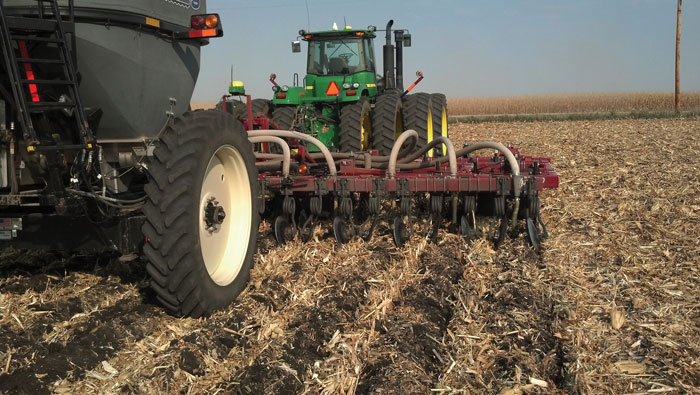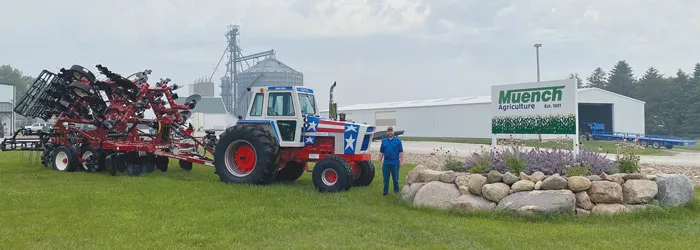In 2009, Mark Muench of Ogden, Iowa, was frustrated about the lack of development for tillage equipment. He felt that it was one aspect of agriculture that had come to a standstill as far as improvements go. After trying Salford tillage equipment, he felt like he was getting closer to what he wanted.
“I had been strip-tilling corn on corn for quite a few years, and I was having some trouble managing corn residue,” Muench says. “That’s why I bought the first Salford, to chop up the residue. I wanted to reduce the number of passes, so I started reconfiguring a Salford to be able to do what I wanted in one pass.”
Muench says that he took his rolling basket and harrow off and put them on the back of the Salford machine — essentially taking all the Salford components and rearranging them for strip-till.
“When I was doing these configurations, I was talking to the Salford engineers a lot, and one day their territory rep was in the area and he stopped by to visit,” Muench says. “He mentioned that they were always trying to get more dealers in my area, and I just got to thinking, ‘Well, gee, I’m always working on these things and learning about them anyway.’ From there, it just kind of fell into place.”
He says that when he first agreed, he thought he would be selling almost exclusively to strip-till customers. He was surprised to find out that there was a high demand for vertical till. Even still, Muench says that he does have a lot of strip-till customers, just not as many as he initially anticipated.
“When you’re strip-tilling, you’re like the quarterback, setting up the play for the whole season…”
“It’s so specialized, and everybody does it differently,” Muench says. “My version of strip-till — I call it hybrid strip-tilling because I still come back in the spring and hit it with a vertical till but we’re still planting over those strips. But just for corn-on-corn residue, I like to hit it in the spring and chew it up a little more just to keep it all in place.”
Muench says he knows that strip-till is not for everyone but he has had a lot of success with it and he finds it to be a welcome challenge compared to conventional or vertical tillage.
“When you’re strip-tilling, you’re like the quarterback, setting up the play for the whole season,” Muench says. You have to know what you’re going to be doing in the fall. And vertical till, once you get the machine set, you can pretty much throw anybody in the cab and go with a few minor tweaks throughout the season.”
Increasing Efficiency
Fast forward to the fall of 2012, and Muench is running a Salford dealership out of his farm shop. He sold his first machine in 2013. Today, he says that his Salford dealership is the largest single-location dealership in Iowa, and that they sell more parts than any dealership in the state.
Muench says because Salford was still relatively new in the grand scheme of agricultural equipment, he knew that farmers weren’t going to just buy equipment without trying it. Because of this, Muench knew there would be a lot of effort involved, but he felt that he was up for the challenge.

HYBRID STRIP-TILL. Mark Muench uses a Salford 1500 strip-till machine to apply phosphorous (P) and potassium (K) into corn residue on a field that’s going to be planted to corn the following spring. Photo: Mark Muench
“I felt like it was my attempt to help improve tillage in general,” Muench says. “It seemed as if tillage, compared to other aspects of agriculture, was lagging behind 30-40 years — especially if you compare it to developments and improvements with tractors and combines. It was my attempt to make tillage a little more sustainable with less erosion by doing it in a better and more efficient way.”
Now Muench says that while it depends on the day, he estimates that his time is split roughly 50/50 between the Salford dealership and his own farm operation, where he primarily grows corn and soybeans. Although since hiring some staff for both the dealership and the farm, he says he probably spends less time doing actual field work.
Understanding Growers’ Needs
Because of Muench’s long family history of farming, he feels he can bring a unique perspective to the dealership side of the agriculture business.
“I feel that my role is to try to get as much history on what the farmer is currently doing and then try to figure out what he’s trying to achieve,” Muench says. “We work with everyone from no-till to maximum tillage to everyone in between. I never want someone to end up with a machine they don’t like, so we put a lot of effort into making sure that doesn’t happen.”
Even if it takes 2 or 3 years, Muench says that he’s committed to making sure his customers are satisfied.
“I built the business from the farmer’s perspective because that’s what I am…”
“We might bring them a demo in the spring or fall one year, and I like to use that as a benchmark to see if the machine is too aggressive or what changes might need to be made,” Muench says.
Having spent so many hours in the field, Muench knows how important it is to find a machine that does what the farmer needs.
“We’ve tried to grow by taking care of customers, having the parts and having the service,” Muench says. “I deal with the big companies all the time from the farmer’s side, and I’m always baffled at how some things slip through the cracks. And I’m not saying we’re perfect, but I built the business from the farmer’s perspective because that’s what I am. I know how critical time is and how frustrating it is not having the right part to keep your machine going.
“I think a mistake machinery dealers make is focusing too much on the machine itself,” Muench says. “We always look at it from the agronomy perspective: the seedbed, the final yield. We’re always asking why are we doing it, what are we trying to achieve and can we improve it? It’s all about a perfect seedbed.”
Muench says that strip-till works well for farmers who are willing to commit to a high-management system, but he thinks many farmers don’t want to spend the time and effort.







